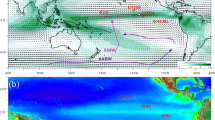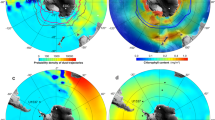Abstract
The low concentration of atmospheric CO2 inferred to have been present during glacial periods is thought to have been partly caused by an increased supply of iron-bearing dust to the ocean surface1. This is supported by a recent model2 that attributes half of the CO2 reduction during past glacial stages to iron-stimulated uptake of CO2 by phytoplankton in the Southern Ocean. But atmospheric dust fluxes to the Southern Ocean, even in glacial periods, are thought to be relatively low and therefore it has been proposed that Southern Ocean productivity might be influenced by iron deposited elsewhere—for example, in the Northern Hemisphere3,4—which is then transported south via ocean circulation (similar to the distal supply of iron to the equatorial Pacific Ocean5,6,7). Here we examine the timing of dust fluxes to the North Atlantic Ocean, in relation to climate records from the Vostok ice core in Antarctica around the time of the penultimate deglaciation (about 130 kyr ago). Two main dust peaks occurred 155 kyr and 130 kyr ago, but neither was associated with the CO2 rise recorded in the Vostok ice core. This mismatch, together with the low dust flux supplied to the Southern Ocean, suggests that dust-mediated iron fertilization of the Southern Ocean did not significantly influence atmospheric CO2 at the termination of the penultimate glaciation.
This is a preview of subscription content, access via your institution
Access options
Subscribe to this journal
Receive 51 print issues and online access
$199.00 per year
only $3.90 per issue
Buy this article
- Purchase on Springer Link
- Instant access to full article PDF
Prices may be subject to local taxes which are calculated during checkout



Similar content being viewed by others
References
Martin, J. H. Glacial-interglacial CO2 change; the iron hypothesis. Paleoceanography 5, 1–13 (1990).
Watson, A. J., Bakker, D. C. E., Ridgwell, A. J., Boyd, P. W. & Law, C. S. Effect of iron supply on Southern Ocean CO2 uptake and implications for glacial atmospheric CO2. Nature 407, 730–733 (2000).
Watson, A. J. & Lefevre, N. The sensitivity of atmospheric CO2 concentrations to input of iron to the oceans. Tellus B 51, 453–460 (1999).
Lefevre, N. & Watson, A. J. Modelling the geochemical cycle of iron in the oceans and its impact on atmospheric carbon dioxide concentrations. Glob. Biogeochem. Cycles 13, 727–736 (1999).
Loubere, P. Marine control of biological production in the eastern equatorial Pacific Ocean. Nature 406, 497–500 (2000).
Coale, K. H., Fitzwater, S. E., Gordon, R. M., Johnson, K. S. & Barber, R. T. Control of community growth and export production by upwelled iron in the equatorial Pacific Ocean. Nature 379, 621–624 (1996).
Wells, M. L., Vallis, G. K. & Silver, E. A. Tectonic processes in Papua New Guinea and past productivity in the eastern equatorial Atlantic. Nature 398, 601–604 (1999).
Boyd, P. W. et al. A mesoscale phytoplankton bloom in the polar Southern Ocean stimulated by iron fertilization. Nature 407, 695–702 (2000).
Mahowald, N. et al. Dust sources and deposition during the last glacial maximum and current climate: A comparison of model results with paleodata from ice cores and marine sediments. J. Geophys. Res. 104, 15895–15916 (1999).
Duce, R. & Tindale, N. W. Atmospheric transport of iron and its deposition in the ocean. Limnol. Oceanogr. 42, 405–418 (1991).
Husar, R. B., Prospero, J. M. & Stowe, L. L. Characterization of tropospheric aerosols over the oceans with the advanced very high resolution radiometer optical thickness operation product, NOAA. J. Geophys. Res. 102, 16889–16901 (1997).
Measures, C. I. & Vink, S. On the use of dissolved aluminium in surface waters to estimate dust deposition to the ocean. Glob. Biogeochem. Cycles 14, 317–327 (2000).
Petit, J. R. et al. Climate and atmospheric history of the past 420 000 years fro the Vostok ice core, Antarctica. Nature 399, 429–436 (1999).
Basile, I. et al. Patagonian origin of glacial dust deposited in East Antarctica (Vostok and Dome C) during glacial stages 2, 4 and 6. Earth Planet. Sci. Lett. 146, 573–589 (1997).
Diekmann, B. et al. Terrigenous sediment supply in the Scotia Sea (Southern Ocean): response to late Quaternary ice dynamics in Patagonia and on the Antarctic Peninsula. Palaeogeogr. Palaeoclimatol. Palaeoecol. 162, 357–388 (2000).
Bareille, G., Grousset, F. E. & Labracherie, M. Origin of detrital fluxes in the southeast Indian Ocean during the last climatic cycles. Paleoceanography 9, 799–819 (1994).
Kumar, N. et al. Increased biological productivity and export production in the glacial Southern Ocean. Nature 378, 675–680 (1995).
Kidd, R. B. et al. King's Trough Flank: geological and geophysical investigations of its suitability for high-level radioactive waste disposal. Inst. Oceanogr. Sci. Rep. 166, 1–98 (1983).
Reiff, J., Forbes, G., Spieksma, F. & Reynders, J. African dust reaching northwestern Europe: A case study to verify trajectory calculations. J. Clim. Appl. Meteorol. 25, 1543–1567 (1986).
Jickells, T. D. & Spokes, L. J. in The Biogeochemistry of Iron in Seawater (eds Turner, G. & Hunter, K. A.) (Wiley, New York, in the press).
Martinson, D. G. et al. Age dating the orbital theory of the Ice Ages: Development of a high-resolution 0 to 300,000 years chronostratigraphy. Quat. Res. 27, 1–29 (1987).
Shackleton, N. J. The 100,000 year ice-age cycle identified and found to lag temperature, carbon dioxide and orbital eccentricity. Science 289, 1897–1902 (2000).
Robinson, S. G. The late Pleistocene palaeoclimatic record of North Atlantic deep-sea sediments revealed by mineral magnetic measurements. Phys. Earth Planet. Inter. 42, 22–47 (1986).
Maher, B. A. & Thompson, R. in Quaternary Climates, Environments and Magnetism (eds Maher, B. A. & Thompson, R.) 1–48 (Cambridge Univ. Press, Cambridge, UK, 1999).
Chapman, M. R. & Shackleton, N. J. Millennial-scale fluctuations in North Atlantic heat flux during the last 150,000 years. Earth Planet. Sci. Lett. 159, 57–70 (1998).
Hovan, S. A., Rea, D. K. & Pisias, N. G. Late Pleistocene continental climate and oceanic variability recorded in Northwest Pacific sediments. Paleoceanography 6, 349–370 (1991).
DeMenocal, P. B., Ruddiman, W. F. & Pokras, E. M. Influences of high-latitude and low-latitude processes on African terrestrial climate—Pleistocene eolian records from Equatorial Atlantic-Ocean drilling Program Site-663. Paleoceanography 8, 209–242 (1993).
Acknowledgements
We are grateful to Southampton Oceanography Centre for allowing sampling of Core 82PCS01. We also thank K. Miller for picking the foraminifera, and S. Dennis and G. McIntosh for performing oxygen isotope and magnetic analyses, respectively.
Author information
Authors and Affiliations
Corresponding author
Rights and permissions
About this article
Cite this article
Maher, B., Dennis, P. Evidence against dust-mediated control of glacial–interglacial changes in atmospheric CO2. Nature 411, 176–180 (2001). https://doi.org/10.1038/35075543
Received:
Accepted:
Issue Date:
DOI: https://doi.org/10.1038/35075543
This article is cited by
-
Characterization of Environmental Dust in the Dammam Area and Mud After-Effects on Bisphenol-A Polycarbonate Sheets
Scientific Reports (2016)
-
Characterizing magnetic mineral assemblages of surface sediments from major Asian dust sources and implications for the Chinese loess magnetism
Earth, Planets and Space (2015)
Comments
By submitting a comment you agree to abide by our Terms and Community Guidelines. If you find something abusive or that does not comply with our terms or guidelines please flag it as inappropriate.



